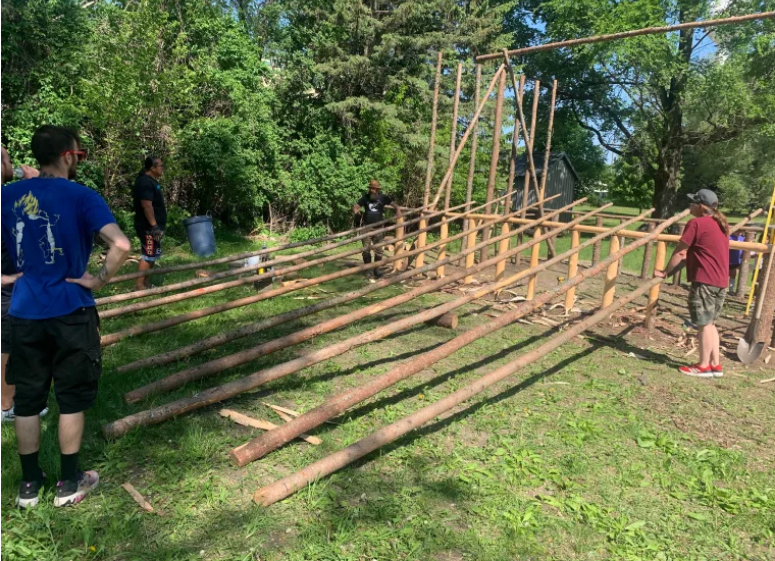The Great Lakes Lifeways Institute is joining forces with Indigenous nations in Minnesota and Ontario to build three elm bark community lodges as part of a growing effort to bring traditional lodges back to the region after more than 100 years.
“These grassroots projects brought together dozens of people, created powerful collaborative synergy between diverse communities and nations, all to create and reestablish traditional spaces for healing, growth, learning, teaching and even birthing,” said Great Lakes Lifeways founder and executive director Kevin Finney.
 The first elm bark lodge to go up was on the Prairie Island Indian Community in Minnesota, followed by construction of another at the Lower Sioux Community in Minnesota. Construction of a lodge for the Aamjiwnaang First Nation in Ontario is scheduled for later this year.
The first elm bark lodge to go up was on the Prairie Island Indian Community in Minnesota, followed by construction of another at the Lower Sioux Community in Minnesota. Construction of a lodge for the Aamjiwnaang First Nation in Ontario is scheduled for later this year.
“We look forward to many gatherings at the lodge for our youth and elders and talking about how and what has happened in these lodges in those days. And so we’re very excited about the first lodge being built here.” says Prairie Island President Johnny Johnson.
Because elm trees have been hit by disease in Minnesota, the construction required travel to Indiana to collect the elm bark necessary for the traditional lodges.
 “We had two large teams representing multiple tribal nations and community organizations spend around two weeks in Northern Indiana to harvest the American elm bark used to cover the lodges,” Finney said. “In order to do this sustainably, ethically and responsibly, we collaborate with hardwood logging operations to locate, select, GPS and mark trees which are already slated to be harvested for lumber or firewood.” To ensure the long-term sustainability of the practices, the institute is working on a plan for elm restoration and planting programs in partnership with multiple tribal nations, Finney said.
“We had two large teams representing multiple tribal nations and community organizations spend around two weeks in Northern Indiana to harvest the American elm bark used to cover the lodges,” Finney said. “In order to do this sustainably, ethically and responsibly, we collaborate with hardwood logging operations to locate, select, GPS and mark trees which are already slated to be harvested for lumber or firewood.” To ensure the long-term sustainability of the practices, the institute is working on a plan for elm restoration and planting programs in partnership with multiple tribal nations, Finney said.
The bark had to be kept wet until it arrived in Minnesota for the construction or it would not have been malleable enough to complete the lodge.
Sean Contreras, who represents Nis’to Inc. a Native youth nonprofit on the Lake Traverse Reservation, took a youth group to help with the recent Prairie Island and Lower Sioux projects. “The bark lodge is a Dakota cultural dwelling that was utilized along with the earth lodge and the tipi as needed for gatherings, food preservation and ceremonial use,” Contreras said. “I was able to bring several Dakota youth with me to help in the construction of the bark lodges,” he said. “Most of them didn’t have previous construction experience but picked up very quickly on the work and were a great help.”

Once special blessings are sent, they begin to harvest the black spruce poles that weigh about 200-300 pounds each. Once they are harvested the logs are peeled and stored above ground on logs to prevent molding. Workers then mark out the perimeter of the lodge and the exact location for each pole. They dig each pole in about a foot to stabilize the pole as it’s being erected. It takes several people to help do this.
Once the frame is completed, pine boards are secured to the bottom to about five feet off the group. This insulates the bottom of the lodge during winter and also prevents the lodge from caving in from high snow that may develop over the winter. Then a support frame is added inside the lodge to secure it during storms and high winds, and materials are put over the lodge to make it waterproof.
Stones are then placed in a circle for a fire in the center of the lodge and a hole is open at the top of the lodge to allow the smoke to exit.
The new lodge will now be used for ceremonies and teachings for young people and the community. It was a community effort to construct and will provide Indigenous youth a language nest and learning space for decades.
You can read the original article at ictnews.org


The likeliest reason for these lodges disappearing in the first place is zoning and building codes. These regulations want conventional construction only.
thanks for that info